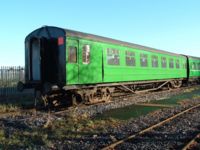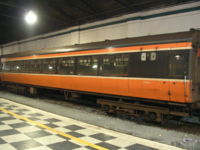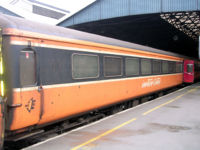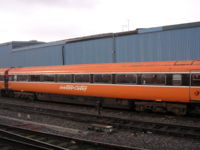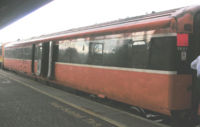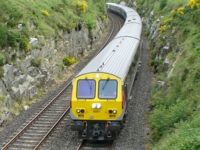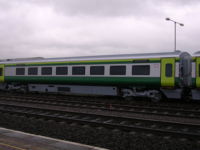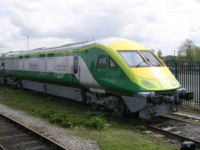Coaching Stock of Ireland
A wide variety of hauled coaches have been used on the railways of Ireland. This page lists all those since 1945.
Contents
Republic of Ireland
When formed in 1945 Córas Iompair Éireann (CIÉ) inherited from its constituents, the most rag - bag collection of coaching stock imaginable. Although many were over 40 years old they had to remain in service until a programme of replacement could be found.
CIE, which controlled the Republic's railways between 1945-86, and its subsidiary, Iarnród Éireann (IÉ) from 1986, have made great use of hauled coaches, though in recent years IE has turned increasingly to multiple units to replace old locomotives and coaches. IE and NIR jointly own the current stock used on the Enterprise service between Dublin and Belfast, with IE nominally owning the odd-numbered vehicles and NIR the even-numbered ones, though all share a common Enterprise livery.
"Park Royal" stock
In 1955 Inchicore Works[1] commenced the construction of 50 coaches from parts supplied by the Park Royal Works in London. These coaches made full use of the Irish loading gauge being 61 ft 6 in long and 10 ft 2 in wide, reducing by 8" at their ends. Because of their aluminium and steel construction, they weighed only 26 tons tare (Suburban) and approx. 27 1/4 tons tare (Main Line). Unusually these coaches had inward opening doors, similar to the American "Pullman" design but this proved unpopular and somewhat confusing to the passengers, and so were rebuilt conventionally. The suburban coach seated 82 while the main line coach, fitted with lavatories, seated 70 passengers. These coaches rode on Commonwealth bogies[2], the first in Ireland to be so fitted. Barred from certain routes during the early 1990s, because of their construction, they were withdrawn following the delivery of the first Japanese DMUs in 1994.
Livery
When built, these coaches received the standard CIE "ivy - leaf" green livery. In the early 1960s they were re-painted in the new black / tan / white colour scheme (See: Cravens stock / livery)
Cravens Stock
In Spring 1961 CIE sought tenders for the supply of 40 new Standard Class coaches, 10 to be delivered complete, the rest "part-finished" for assembly in Inchicore with technical assistance from the suppliers. The £500,000 contract was awarded to Cravens of Sheffield for a contemporary of the British Railways Mark 1. It was reported that these new vehicles "would set a pattern for future construction of CIE carriage stock." The first of the Sheffield-built coaches was unloaded at the North Wall, Dublin on 3rd May 1963 and taken to Inchicore for acceptance.
These new coaches were built with light alloy bodies on steel underframes on Type B4 bogies.
Each saloon had 64 seats, arranged in eight bays of four around a table, either side of a central gangway, with two toilets situated in the vestibule at one end. The interior was finished in laminated plastics, creating a light and airy feel. They were fitted with a public address system, double-glazed windows and central fluorescent lighting along their length, the first coaches in Ireland to be so treated,. Heating was by steam, supplied from a Steam Heating Van.
They were 62 ft 8 in long, 9 ft 6 in wide, 12 ft 7.5 in high, weighed 28 tons and 14 cwt. and were numbered 1504 to 1513. The 30 incomplete coaches were numbered 1514-1543, and although the total order was for 70, only 15 more (numbered 1544-1558) were built to a total of 55.
During early 1963, Inchicore commenced construction of two new First Class coaches in a style similar to, but not connected with, the Craven contract. These coaches were built with an open plan format, double-glazing and air conditioning. Numbered 1145 and 1146, they were the only post-war all-first class coaches to be added to the stock, their immediate predecessor, 1144, was built in 1935.
On 2nd April 1964 the new coaches were demonstrated to the press and entered service on 10th April, working the 18.30 Dublin to Cork train. They were common on high capacity specials, with 14 vehicle trains (12 "Cravens" + 2 Gen Vans) not being untypical, a capacity of 768 passengers!
Throughout 2006 a phased withdrawal of the Craven stock took place. Their final regular duties were "Fridays Only" workings from Dublin Heuston to Cork, Galway, Limerick and Tralee and their return. They were also occasionally used for rugby union and football match specials and other one-off services.
The final set in scheduled service was withdrawn on December 11th, 2006 after working the 05:15 Athlone - Dublin Heuston service. The last operation in IÉ ownership was an RPSI steam special on December 17th.
Livery
The Sheffield built coaches were outshopped and delivered in the new CIE livery of tan below the waist, black on the central panel at window level, roof and ends, with a broad (6"/150 mm) white band between the upper window and roof. Large, white, class numerals were applied to the doors. The two Inchicore First Class coaches were similarly treated. Later on a thin white band of approx. 1" / 25 mm was applied to the waistband, separating the tan and black sections. Following the re-branding to Irish Rail in 1988, two white 3 inch (75 mm) vinyl strips were added, separating the black from the tan above and below it. Two reflective Fluorescent Red 3M Scotchcal 12 inch square panels were applied at each body end.
Mark 2
In 1972 CIÉ placed an order with BREL for 72 new coaches based on the British Rail Mark IId design. These were built at the Litchurch Lane workshops in Derby. With air conditioning as a principal feature they became known as “AC Stock” and ran on type B4 bogies, with vacuum brakes.
The order consisted of 6 First Class coaches (5101 to 5106), 9 Composites (5151-5159), 36 Standard Class (5201-5236), 11 Restaurant / Buffet / Standard Class (5401-5411) and 11 Generator Vans (5601-5611). Internal fit-out was done in Inchicore, and was quite different to the original BR design, using bench seating rather than individual seats and made extensive use of wood veneer panelling.
Their electrical system also differed from the BR and NIR versions. The Generator Van contained two engine / generator sets, each supplying 220 / 380 Volts 50 Hz AC to two separate "busses" in the train. The air conditioning loads were divided in half, each half fed from each "buss". In the case of failure of one generator set, the other set automatically supplies both "busses". Air conditioning output power would then be halved, but all other loads including Cooking, Lighting and Battery Charging continue to be supplied. This has remained the model for the electrical power supply on all subsequent IE coaches.
To accommodate changes in traffic, five of the Composites, 5153-5156 and 5158 were re-classed as "Standards", while one of the Restaurant / Buffet / Standards, 5408, was converted for use as the Presidential Coach.
They are still running the mid-day Intercity routes to Galway and Limerick, but are expected to be phased out in late 2006.
Mark 3
Introduced on the CIE system in 1986 they currently serve the intercity routes of Cork, Dublin and Galway. The decision to purchase a new fleet of modern Intercity coaches based on the British Rail Mark 3 design was made as a result of several accidents involving the older style, wooden framed, coaches. They were already a well-proven design used for BR’s High Speed Trains (HST) The first 44 Open Standards and all of the Buffets and Generator Vans were built at BREL’s Litchurch Lane workshops in Derby. The remainder was built under licence in Inchicore between 1980 and 1989. The coaches ran on 5 ft 3 in gauge versions of British Rail’s BT22 Air Suspension bogie,[3] and were air-braked.
The Mark 3 fleet, as it stands in 2005, comprises 123 standard coaches. Thirty coaches were converted for push-pull operation on the suburban rail service. Although originally air conditioned, these coaches were fitted with opening windows and had the air conditioning removed.
In 2004 a 1979 vintage BR Mark 3 TRFK coach was converted by Interfleet into a modern Snack Car[4] for use on a Push-pull set.
The Irish Mark 3 coaches are similar, but not identical, to their British counterparts. They have a different electrical system (220/380V 50 Hz) and were the first Mark 3s to be fitted with automatic swing-plug doors. There are also some different internal layouts more specifically suited to Irish traffic.
The Mark 3A "Cu Na Mara" set, which operates exclusively on the Dublin to Galway route, was originally the BREL International Train, a showcase project designed to secure overseas orders. The set travelled to a German rail exhibition in 1988, but returned without any new orders and languished for some years before being sold on through Vic Berry. CIE converted the many different interior layouts to their own standard design, fitted their own Mk 3 type powered door and re-bogied with ABB bogies. Although also re-wired for Push-Pull operation the fact that the "10th coach" wasn't converted to a DVT prevented the set from ever running with this configuration.
This set marked the end of coach building in Inchicore.
The plug door design found on the CIE Mark 3 coaches was later used on the British Rail Class 442 long distance commuter train.
De Dietrich Stock
Following the introduction of the new Class 201 locomotives, the jointly operated " Enterprise" service between Dublin and Belfast was upgraded in September 1997 with new coaching stock from French train makers De Dietrich Ferroviaire (now Alstom DDF)
The coaches are divided into two classes: Standard, with 2 + 2 seating and “First Plus”, with 2 + 1 seating, individual reading lamps and power adjustable seating with "in seat" audio. All coaches are air conditioned, have powered internal and external doors, tinted windows with adjustable blinds, a single wheelchair accessible toilet with baby changing facilities, LED route maps and scrolling LED information displays.
Electrical power for train HVAC, battery charging and cooking is supplied from the locomotive's Head End Power system as the sets do not include a Generator Van.
Although originally ordered as four sets of seven cars, each of the three in-service sets comprise 8 cars:
- One DVT (No’s 9001 to 9004), with Driving Cab, luggage area, 29 seats & wheelchair space, weight 42 ton
- One "First Plus" (No’s 9101 to 9104) with 47 seats, weight 38 ton
- One Café / Buffet, (No’s 9401 to 9104), weight 40 ton
- One Standard (No’s 9213 to 9216) with 68 seats & wheelchair space, weight 38 ton
- Four Standard (No’s 9201 to 9212) with 71 seats, weight 38 ton.
Each carriage is 23.43 m (76 ft 10.4 in) long, 3.787 m (12 ft 5 in) in height and 2.814 m (9 ft 2.8 in) wide.
The odd numbered coaches are owned by IE and the even numbered by NIR
Mark 4 (CAF)
67 Mark 4 coaches were delivered in 2006 from CAF[5]
Although the name "Mk 4" has entered common usage, these trains have no connection to the BR Mk 4.
Capable of 200 km/h operation, this higher speed would require track & signal system upgrade and provision of a faster locomotive than the currently used 201 class. One possibilty being considered is to replace the existing locomotive with two power cars, one of which would be converted from the existing Generator Control Car.
Seating capacity is 493 (8-car set) and the train is fully accessible to mobility-impaired customers.
Capable of 10-car operation, each in-service set will comprise of 8 cars:
- Generator Control Car - GC (or DVT)
- One First Class - FC
- One Catering Car - CC
- Four Standard Class - SC
- One Standard End - SCE, with retractable buffers & drop-head buckeye coupling at locomotive end.
- Length between couplers - 23.66 m (77 ft 7.5 in)
- Height - 3.85 m (12 ft 7.5 in)
- Width - 2.85 m (9 ft 4 in)
Seven sets will operate on the Dublin-Cork route on an enhanced hourly clockface timetable from mid January 2007. This will allow Mark 3 carriages, currently in use on Dublin-Cork, to replace the older (and tired looking) Mark 2 carriages presently operating the Limerick, Galway and Waterford routes.
Main Features
- Merak HVAC[1]
- Power operated passenger doors
- Fire resistance to BS 6553:1999 Cat 1B
- Public address (PA)
- Closed-circuit television (CCTV) recording, including a forward facing camera in the DVT
- LED Exterior & Interior Destination signs
- Seat Reservation system with reserved seating LED displays above each passenger seat. System is updated via Wireless LAN (W-LAN)
- LED Route Maps
- In-seat audio in First Class
- Power operated seating in First Class
- Suspension:
- Primary coil springs & secondary air bags
- Sanding on leading axle of GC & trailing axle of SCE cars
- Scharfenberg coupler[2] between cars, drop-head buckeye couplers[3] each end
- Wheelchair area & accessible toilets to UK Rail Vehicle Accessibility Regulations
Mark 4 DVT
- Air-conditioned driver's cab
- Fault Diagnostic system, displayed on driver's monitor
- Luggage Compartment
- Fire Suppression System
- Generators:
- Length between couplers - 23.81 m (78 ft)
Liveries since inception of CIE
Carriages
Carriages were originally dark (malachite) green, pale (apple) green broad stripe above and below windows and the flying snail emblem ![]() . A lighter shade with a pale green waist was introduced in 1955 for the Park Royals. At the end of 1955 unpainted aluminium coaches were introduced with large red 1s and 2s to indicate class and small red running nos. From 1958 all carriages were repainted standard green.
. A lighter shade with a pale green waist was introduced in 1955 for the Park Royals. At the end of 1955 unpainted aluminium coaches were introduced with large red 1s and 2s to indicate class and small red running nos. From 1958 all carriages were repainted standard green.
In 1961, with the introduction of the "Cravens Stock", a radical new livery was introduced comprising of black upper panels, roof and body ends, deep orange (golden brown / tan) lower panels with a 6-inch white band between the windows and the roof.
In 1988, CIE was re-branded as Irish Rail and the 6-inch white band was replaced by two 3-inch white bands, on each side of the black portion. The words “InterCity” ![]() in large white lettering was added on the lower orange-brown section accompanied by the "IR" logo.
in large white lettering was added on the lower orange-brown section accompanied by the "IR" logo. ![]() Craven coaches and ex-BR Mk 1 generator vans were not re-branded. These continued in CIE black and golden brown but the white lining was changed to the narrower style on their next works visit.
Craven coaches and ex-BR Mk 1 generator vans were not re-branded. These continued in CIE black and golden brown but the white lining was changed to the narrower style on their next works visit.
In the early 1990s, the golden brown was replaced by a brighter orange (RAL 2012) and the stylised IE icon ![]() replaced the IR track logo. The new logo did not accompany the Intercity lettering
replaced the IR track logo. The new logo did not accompany the Intercity lettering ![]() , but was put on all MK2 and MK3 coach doors.
, but was put on all MK2 and MK3 coach doors.
Because of the shared nature of the service the Enterprise has its own unique livery comprising of Dark Grey (NCS 8502-Y), Light Grey (NCS 5502-Y), Dark Green (NCS 9005-G20Y), Bronze strip & Enterprise logos (3M), and either Purple (NCS 5040-R40B) for Standard Class or Dark Red (NCS 4060-R10B) for First Plus.
In 2006, a new livery reminiscent of the original green has been introduced on the CAF Mark 4s. Consisting of Fern Green (NCS 4550-G), Grey (RAL 7000), Yellow (RAL 1021), Black (RAL 9005), Green (NCS 7020- B70G), Yellow Green (NCS 1070 G60Y) & Metallic Silver (761). A new logo has also been introduced to match.![]()
Freight
Wagons were Oxide brown and departmental stock a dull grey.
Northern Ireland
Although the majority of passenger services in Northern Ireland have been worked by diesel multiple units since the mid-1950s, a number of hauled coaches have been required under the tenure of both the Ulster Transport Authority (1948-1966) and Northern Ireland Railways (since 1967). From 2001, NIR prefixed their numbers with “8” so as to be part of the Translink number series, which incorporates their road vehicles, resulting in NIR locomotive 8113 sharing the same number as DART car 8113. The table below lists the hauled passenger coaches currently in service, excluding the "De Dietrich" stock jointly owned with IE for operating Enterprise services between Belfast and Dublin:
| NIR Number | Introduced | BR Number(s) | Built | Type |
|---|---|---|---|---|
| 911 / 8911 | 1981 | 14104 | 1969 Derby | Generator Van (ex-Mark 2B BFK) |
| 8941 | 2001 | 6089 / 72634 | 1974 Derby | TSO (ex-BR Class 488 unit 8318) |
| 8942 | 2001 | 6098 / 72637 | 1974 Derby | TSO (ex-BR Class 488 unit 8318) |
| 8943 | 2001 | 6082 / 72605 | 1974 Derby | TSO (ex-BR Class 488 unit 8305) |
| 8944 | 2001 | 6080 / 72609 | 1974 Derby | TSO (ex-BR Class 488 unit 8305) |
| 8945 | 2001 | 6017 / 72626 | 1974 Derby | TSO (ex-BR Class 488 unit 8314) |
| 8946 | 2001 | 5974 / 72627 | 1974 Derby | TSO (ex-BR Class 488 unit 8314) |
| 8947 | 2001 | 6078 / 72646 | 1974 Derby | TSO (ex-BR Class 488 unit 8319) |
| 8948 | 2001 | 6081 / 72647 | 1974 Derby | TSO (ex-BR Class 488 unit 8319) |
